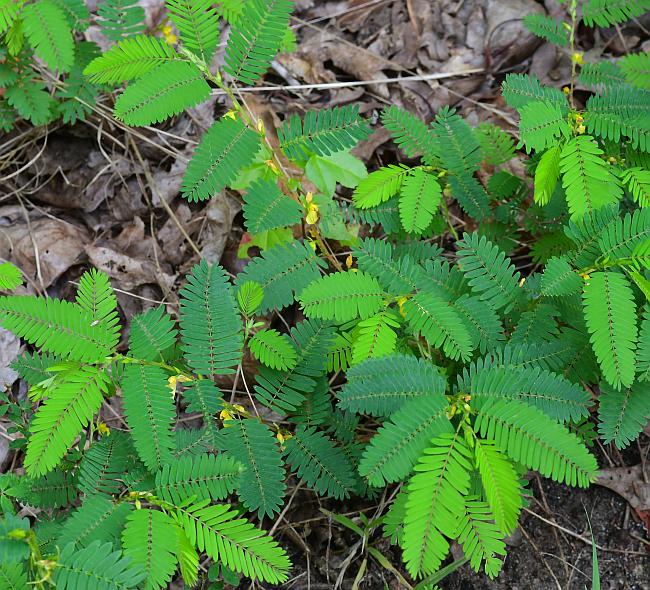Chamaecrista nictitans (L.) Moench
Small-Flowered Partridge-Pea

Native
CC = 2
CW = 3
MOC = 58
© SRTurner
Chamaecrista nictitans (L.) MoenchSmall-Flowered Partridge-Pea | |
 |
Native CC = 2 CW = 3 MOC = 58 |
© SRTurner |
|
Family - Fabaceae/Caesalpinioideae Habit - Taprooted annual forb, with nodules present on roots. Stems - Ascending to erect, to 40 cm, widely branching above the base, herbaceous but stout at the base, antrorse pubescent.
Leaves - Alternate, stipulate, even-pinnate, with 6-18 pairs of leaflets. Stipules erect, appressed, narrowly lanceolate-triangular, usually somewhat asymmetric, acuminate, conspicuously nerved, 3-6 mm long, 1.2-1.4 mm wide at the base, green but often with a reddish apex, glabrous or inconspicuously hairy. Gland of the petiole 0.5-1.0 mm long, usually stalked, purplish. Petiole and rachis antrorsely pubescent. Leaflets sessile, opposite, entire, 6-10 mm long, 1-2 mm broad, oblong, oblique at the base, mucronate, glabrous or minutely hairy, deep green adaxially, light green abaxially, lateral veins evident abaxially.
Inflorescence - Axillary, of solitary or paired flowers, the stalks 2-3 mm long, the bracts linear-lanceolate, 1.5-2.0 mm long, exceeding the pedicel. Pedicels short, to 1.2 mm long.
Flowers - Strongly asymmetric, 8-10 mm in diameter. Sepals 3-4 mm long, lanceolate, sharply pointed, hairy. Petals dimorphic, glabrous, with 1 larger petal 4-6 mm long, 3-4 mm wide, obovate, tapered to a stalklike base; and 4 smaller petals 2.6-3.0 mm long, 1.5-2.0 mm wide, yellow. Stamens 5 (rarely with 1 or 2 additional smaller staminodes), slightly unequal, oriented toward the lower side of the flower, glabrous, the filaments whitish, short (to 1.2 mm long), the anthers 1.4-2.0 mm long, purplish or reddish, apically dehiscent. Ovary 1.5-2.0 mm long, green, hairy, the style 1.4-1.6 mm long, greenish, glabrous.
Fruits - Legumes 2.0-3.5 cm long, 4-5 mm wide, finely hairy. Seeds 3.0-3.2 mm long, 1.5-2.0 mm wide, nearly square, the surfaces finely pitted, dark brown, shiny.
Flowering - July - September. Habitat - Glades, forest openings, bluff ledges, fields, pastures, roadsides, railroads. Usually on acid soils. Origin - Native to the U.S. Lookalikes - Chamaecrista fasciculata. Other info. - This little species can be found in Missouri mainly south of the Missouri River. Its U.S. range encompasses the southeastern and New England portions of the country. When in flower, the plant is easy to ID because of its small yellow flowers and finely pinnate leaves. In the absence of flowers it is difficult to distinguish from its showier sibling, C. fasciculata. Photographs taken in Brown Summit, NC., 9-8-02 (DETenaglia); also at Holly Ridge Conservation Area, Stoddard County, MO, 8-15-2009 and 8-16-2021, and Sand Prairie Conservation Area, Scott County, MO, 8-12-2015 (SRTurner). |